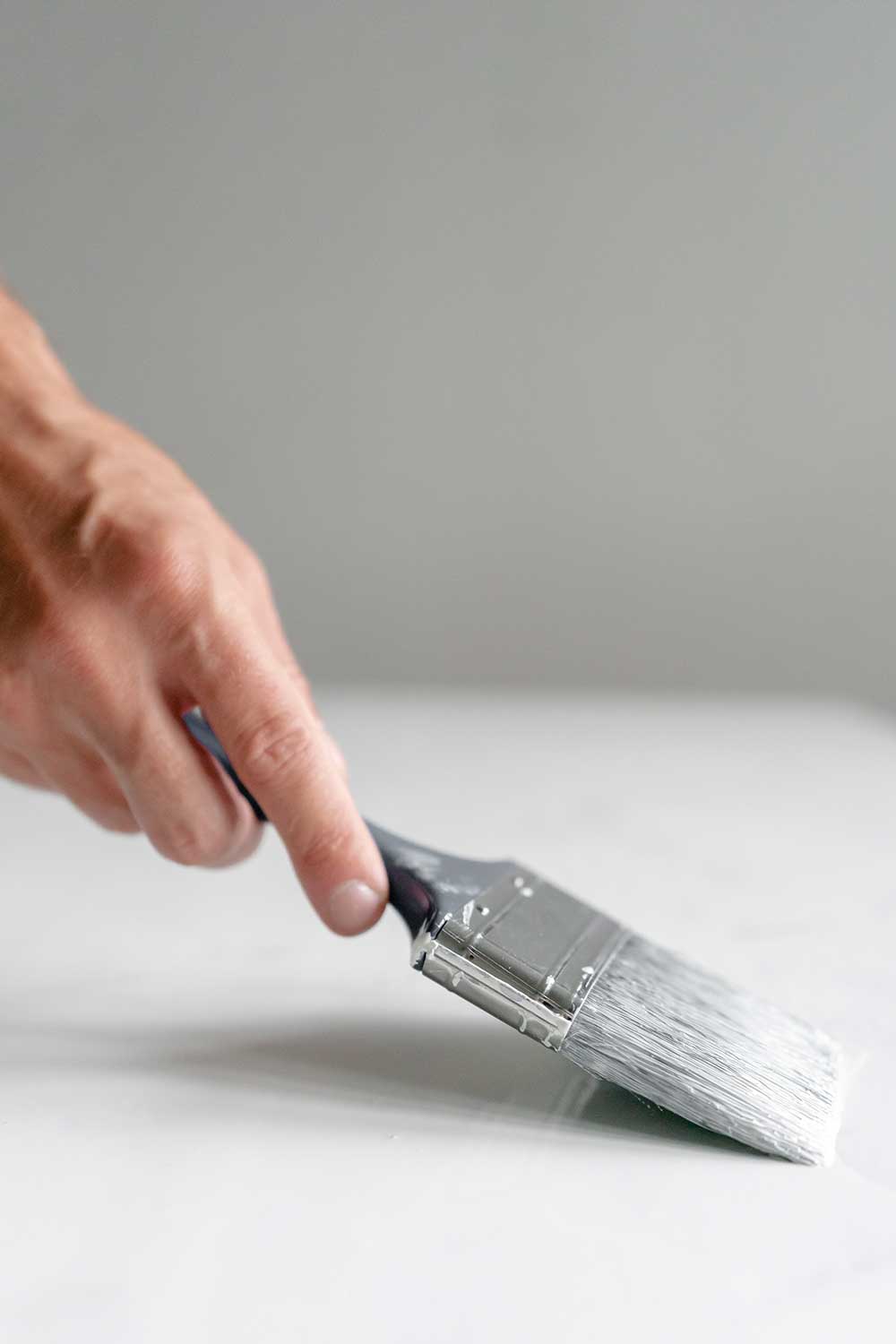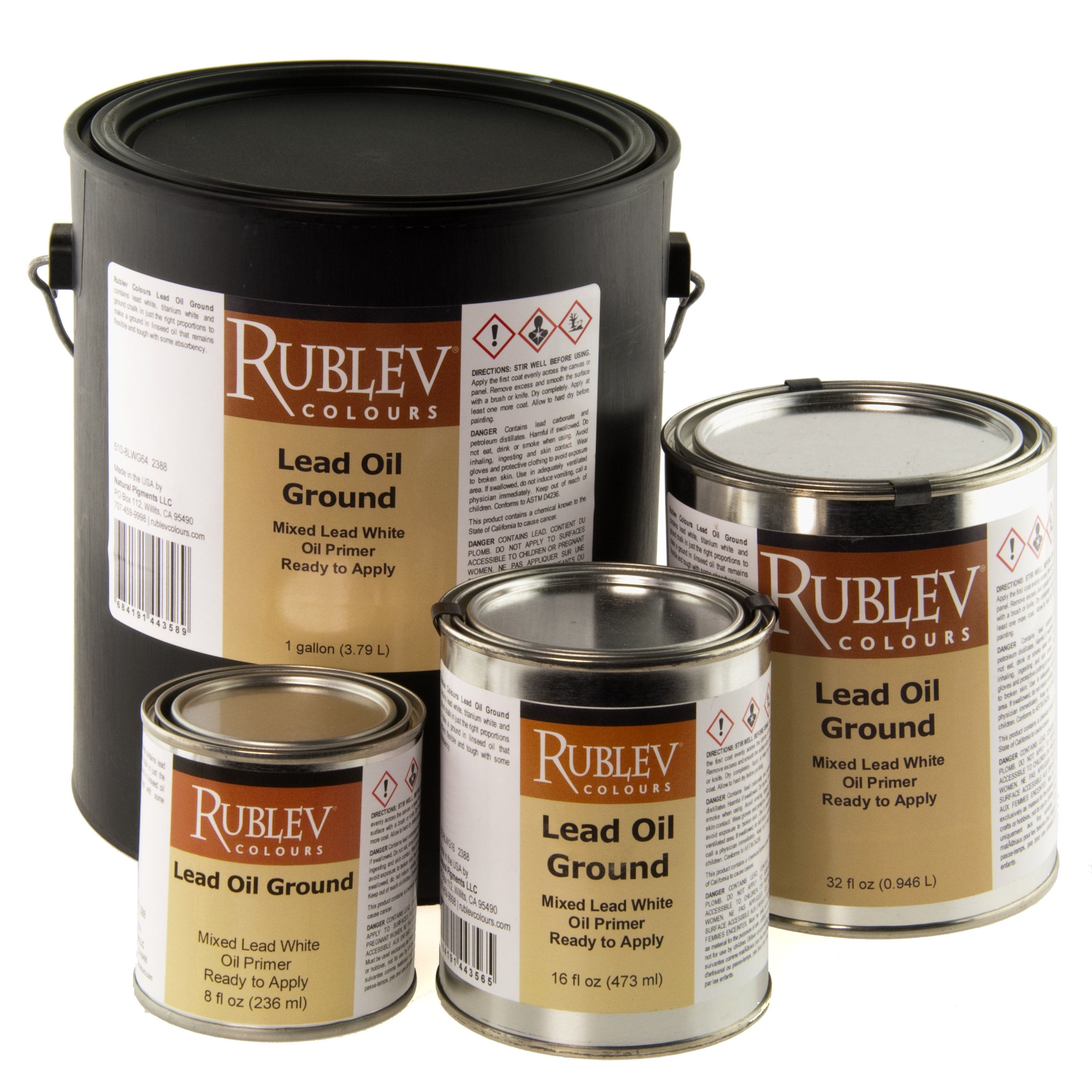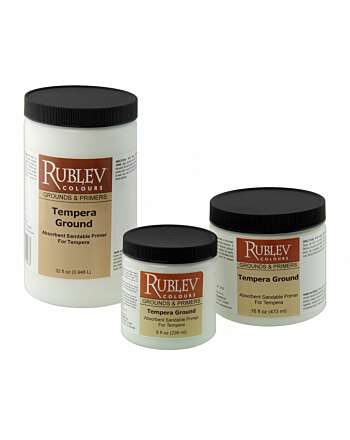
The ground is the layer applied to the support to prepare it to receive paint. Painting grounds have several functions; the most essential is to provide a surface favorable to the application of paint. Grounds also change the absorbency of the support, reduce or enhance its texture, provide a different texture entirely, and create a surface that forms a good bond between the support and the paint layer. The ground is crucial to the durability of the painting. De Mayerne noted as early as the 17th century that quality materials were as essential to the ground layer as the paint layer.
Grounds can be divided into two broad categories according to their absorbency: absorbent and relatively non-absorbent or semi-absorbent.
Absorbent grounds are essentially tempered, water-based grounds prepared with glue or casein. The most common solid materials of absorbent grounds were chalk, calcium carbonate, and gypsum, calcium sulfate.
Strictly speaking, gesso (the Italian word for gypsum) refers solely to absorbent grounds made with gypsum, commonly used for the grounds of Italian panel and canvas paintings from medieval times to the end of the 16th century. Gypsum is the principle ingredient in gesso grosso and gesso sottile described by Cennino Cennini in his 15th century painting handbook, Il libro dell' Arte o Trattato della Pittura. Chalk occurs naturally in Northern European countries; for this reason, it was the most widely used in absorbent grounds in those areas.
Grounds bound with casein are generally less absorbent than grounds made with animal collagen, such as technical gelatin, hide glue, or rabbit skin glue.
Semi-absorbent grounds usually comprise those made with oil or emulsions of oil-in-water. Oil grounds were adopted for their flexibility when canvas supports were developed. The advantage of an oil ground beneath an oil paint layer is that it provides a relatively non-absorbent foundation, which enhances the inherent gloss of oil paint.
Emulsions of glue or casein and linseed oil are called half-chalk grounds and are suggested for painters who want to combine the advantages of oil grounds (flexibility) with those of chalk grounds.
In the 20th century, acrylic dispersion grounds (misnamed acrylic gesso) were developed to answer the problem of slow drying inherent in oil grounds. Despite their popularity, some painters find this type of ground inconvenient for oil painting and entirely unsuitable for tempera.
Absorbent Grounds
Rublev Colours® Easy Gesso
Easy Gesso is an easy way to make traditional chalk grounds. This is a dry mix of calcite and rabbit skin glue in just the right proportions, making it easy to use. Mix equal amounts by volume of Easy Gesso and water, wait one hour to gel, and then warm until it is liquid enough to apply with a brush. Easy Gesso can also be applied at room temperature with a surface or putty knife as a soft gelatinous mass similar to tofu. The difference between real gesso and acrylic “gesso” or primers is the silky soft surface absorbent to water- and oil-based paints.
Contains medium dry-ground calcite (chalk), medium dry-ground marble (dust), and rabbit skin glue.
Available in 500 grams (1.1 lbs.) and one-kilogram bags (2.2 lbs.).
How to Use
- Mix equal parts of dry Easy Gesso into a container with warm water.
- Stir and allow to stand for at least one hour. It will gel.
- Place the container in a pot full of hot tap water. The gel will liquefy and can be brushed on. Allow each coat to dry.
- Sand and apply the next coat.
- At least four sanded coats produce the best surface for painting.
Rublev Colours® Easy Gesso Extra-Fine
Easy Gesso Extra-Fine is a new formulation of our original Easy Gesso but with extra fine natural ground chalk and titanium dioxide. Prepare in the same way as Easy Gesso for a ground with a little less tooth. Use for all water-based and oil paint on rigid supports. It polishes to a very smooth, bright white finish.
Contains fine dry-ground calcite (chalk), fine dry-ground marble (dust), titanium white (titanium dioxide), and rabbit skin glue.
Available in 500 grams (1.1 lbs.) and one-kilogram bags (2.2 lbs.).
How to Use
- Mix equal parts of dry Easy Gesso Extra-Fine into a container with warm water.
- Stir and allow to stand for at least one hour. It will gel.
- Place the container in a pot full of hot tap water. The gel will liquefy and can be brushed on. Allow each coat to dry.
- Sand and apply the next coat.
- At least four sanded coats produce the best surface for painting.
Rublev Colours® Traditional Silverpoint Ground
Traditional Silverpoint Ground is a ready-to-use dry mix ground based on Cennini’s 15th-century recipe that provides a suitable abrasive surface for silver and other metal point drawing applied to paper or wood. Mix with an equal amount of water and warm until it is liquid enough to apply with a brush.
Contains fine dry-ground calcite (chalk), titanium white (titanium dioxide), rabbit skin glue, and other finely ground minerals.
Available in 500 grams (1.1 lbs.) and one-kilogram bags (2.2 lbs.).
How to Use
- Mix equal parts of dry Traditional Silverpoint Gesso into a container with warm water.
- Stir and allow to stand for at least one hour. It will gel.
- Place the container in a pot full of hot tap water. The gel will liquefy and can be brushed on. Allow each coat to dry.
- Sand and apply the next coat.
- At least four sanded coats produce the best surface for painting.

Rublev Colours Lead Oil Ground is a blend of white pigments and linseed oil for a semi-absorbent ground ideal for oil painting. It dries within two days to one week, depending upon local conditions, such as humidity, light, and temperature. You can usually begin painting within two weeks if allowed to dry in a warm, well-lit, and dry environment.
Rublev Colours Lead Oil Ground contains ground calcite, lead white, and titanium white in just the right proportions to make a paint film that remains flexible and tough with some absorbency. The blend of linseed oil penetrates the support to ensure good adhesion yet maintains sufficient holdout to form a good foundation for paint layers. It provides good leveling properties, so brush and knife marks are minimized.
Rublev Colours Lead Oil Ground has a high concentration of pigments, so only two coats are usually necessary, but more coats create smoother surfaces. Apply directly onto panels without sizing or on canvas sized with PVA or rabbit skin glue. Rublev Colours Lead Oil Ground is an excellent foundation for oil and alkyd paints.
The essential characteristics that grounds should have are (1) adhesion, (2) flexibility, (3) penetration control, (4) a type of surface to which upper layers can adhere well, (5) blister and crack resistance, and (6) good application properties. A careful selection of ingredients in an oil ground is essential to impart these qualities to the ground. Ground natural calcite (calcium carbonate) in combination with lead white (basic lead carbonate) and a maximum chalk-resistant grade of rutile titanium dioxide have proven to be an excellent choice of pigments in such oil grounds.
Three Pigments in One Ground
We make Rublev Colours Lead Oil Ground using all three white pigments; calcite, lead white, and titanium white in just the right proportions to make a flexible, tough film with some degree of absorbency.
The dry ground calcite we use in Rublev Colours Lead Oil Ground has a closely controlled particle size distribution. This grade of calcite is designed to provide the lowest possible oil absorption. It offers the desired penetration control with maximum chalk resistance. Calcite aids in forming the type of surface on grounds to which upper layers will adhere easily.
Lead white, and to a lesser degree, ground calcite, have low water absorption properties and hence develop better blister and crack resistance. Furthermore, lead white contributes to more film flexibility.
The presence of titanium white increases the opacity of this ground and provides a brilliant white surface. We have selected a grade of titanium white that exhibits good hiding and excellent dispersion properties.
Does Not Contain Zinc White
Many manufacturers use zinc oxide to get a brighter white in their white grounds and paint. Zinc oxide is not recommended in oil grounds since it tends to cause blistering and cracking in oil paint and grounds. We have not used any zinc in this product.
Pure Linseed Oil
After many trials, we have carefully chosen a specific blend of refined and raw linseed oil with heat-bodied linseed oil such that there is a limited penetration of the oil into the canvas or panel to assure good adhesion to this substrate and yet maintain sufficient holdout to establish a good foundation for the upper layers. This blend of linseed oil also provides the best possible leveling properties, so brush, and knife marks are minimized.
Rublev Colours Lead Oil Ground is ready to apply to canvas or panels without thinning. It is available in 8 fluid ounce (473.2 ml), 16 fluid ounce (pint or 473.2 ml), and 32 fluid ounce (quart or 0.95 L) cans.
How to Use
Rublev Colours Lead Oil Ground has the consistency of heavy cream, so it can be used straight from the can and applied with a brush or knife. Although not required, it can be thinned with turpentine or mineral spirits.
We recommend at least two thin coats on a panel or a sized canvas. This ensures even coverage and hastens drying. Drying time depends on many factors, so it isn’t easy to give a recommendation that covers all applications, we recommend waiting at least 14 days before painting, and more time may be required. Here are our recommendations for using this product:
- Stir the contents of the can before using. Some settling of the pigments will occur and is normal.
- Apply the ground straight from the can with a palette knife, plastic trowel, or brush to an adequately sized canvas or panel if it is too thick to spread easily in a thin layer, thin with a small amount of mineral spirits or spirits of gum turpentine.
- Use a brush to smooth out any knife or lap marks to obtain an even, consistent coating.
- We do not recommend sanding any lead oil ground because this will create dust containing lead. If you find it necessary to sand the ground, we recommend wet sanding it once it has dried thoroughly.
- Allow the ground to be dry, usually overnight or in a day or two, depending upon local conditions. Apply a second coat, repeating the procedure above. More coats can be applied, but two thin coats are recommended.
- You can begin painting when the ground has dried thoroughly, usually about two weeks in warm environments and prolonged in cool, damp environments.
- You can dilute Rublev Colours Lead Oil Ground with mineral spirits or spirits of gum turpentine for thinner coats that may be easier to spread over pre-primed canvas or boards with acrylic-dispersion grounds.
Lead Oil Ground Questions and Answers
Can Rublev Colours Lead Oil Ground be thinned with turpentine for application?
Rublev Colours Lead Oil Ground can be thinned with turpentine or mineral spirits, however, do not over-thin. It is the consistency of heavy cream, so it can be used straight from the can and applied with a brush or knife. This consistency is best suited to penetrate the weft and warp of canvas or the grain of wood panels.
If I applied a single coat of Rublev Colours Lead Oil Ground on sized canvas, would that be sufficient as a ground for oil painting?
We recommend at least two thin coats over a sized canvas or panel instead of a single application of a thick coat of oil ground. This ensures even coverage of the ground and speeds drying. Oil paint dries through autoxidation by exposure to air. The drying begins at the surface and gradually penetrates through the layer of oil. To completely harden, oil paint must dry through the entire layer. If the layer is thin, it has more surface area exposed to the air per volume of the vehicle; hence, this process proceeds more rapidly.
Wait until the first coat is dry to the touch before applying the next coat of Lead Oil Ground.
After applying, how long do I have to wait before I can paint over it?
That depends on many factors, such as the relative humidity, temperature, light exposure, application thickness, substrate absorbency, etc. It isn’t easy to give a recommendation that covers all applications, but we recommend waiting at least two weeks before painting over it, and more time may be required.
Is Rublev Colours Lead Oil Ground flexible enough for large stretched canvases, or is it only suitable for panels or panel-mounted canvases?
It forms a flexible coating for stretched canvases even when applied in multiple layers.
What role does the calcite play?
The medium dry ground calcite in Rublev Colours Lead Oil Ground has a closely controlled particle size distribution. This grade of calcite provides the lowest possible oil absorption, reducing the amount of vehicle necessary to make a flowing ground and allowing it to contain more pigment (pigment volume concentration or PVC). The high PVC (above 40%) of Rublev Colours Lead Oil Ground makes a stronger film, and calcite gives the grounds the desired penetration control with maximum chalk resistance. Calcite aids in forming the type of surface to which upper layers adhere easily—it provides the “tooth” necessary for good adhesion.
What type of bodied oil is used as an ingredient of Rublev Colours Lead Oil Ground?
Rublev Colours Lead Oil Ground contains bodied linseed oil that is heat treated in a vacuum until it reaches the consistency of honey—Z6 viscosity on the Holt-Gardner scale. Bodied oil gives Rublev Colours Lead Oil Ground good flow-out and leveling properties, minimizing the need to scrape or sand smooth the ground to eliminate brush or knife marks.
Can I add driers to Rublev Colours Lead Oil Ground to reduce the drying time?
Rublev Lead Oil Ground already contains a blend of lead, cobalt, and calcium driers accurately added to provide the best drying characteristics. Adding more driers to the oil ground will not reduce the drying time significantly and possibly deter drying.
WARNING: CONTAINS LEAD AND PETROLEUM DISTILLATES. Harmful if swallowed. When using, do not eat, drink or smoke. Avoid ingestion and skin contact. Wear gloves and protective clothing to avoid exposure to broken skin. If swallowed, do not induce vomiting. Call a physician immediately. KEEP OUT OF REACH OF CHILDREN.

















